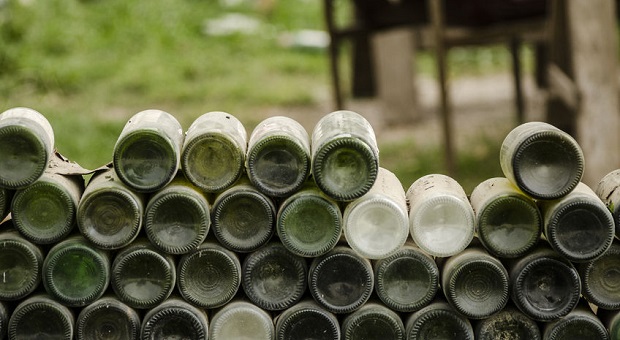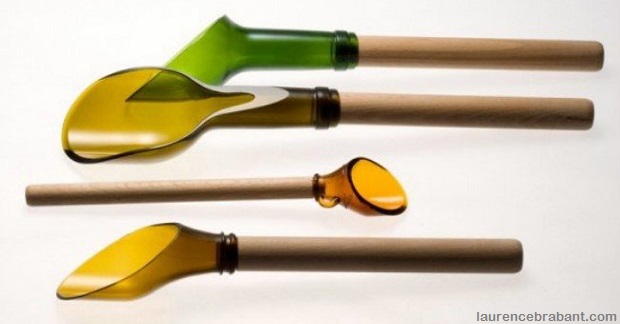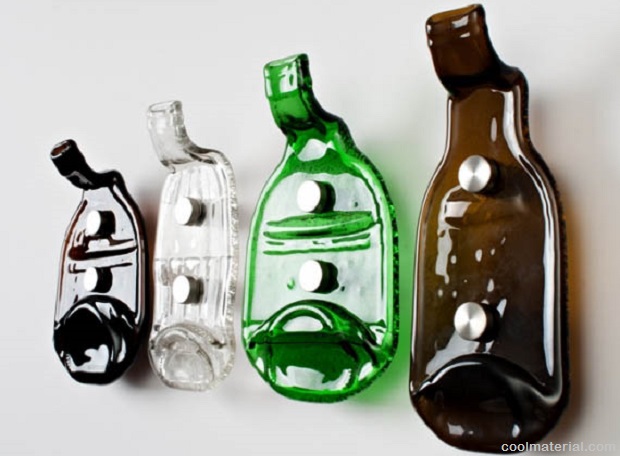The DIY saga continues in the next episode depicting Chris Black’s adventures in the world of recycled materials and do-it-yourself projects. In today’s show, we’ll take a peek at 7 DIY projects involving glass bottles this time.
Why glass bottles, you may ask?
Well, maybe because glass is an infinitely recyclable material and glass bottles are abundant? Or maybe because glass is a very durable material, virtually indestructible (unless hit hard enough) and makes for a great building material?
Let’s start the show with one of the coolest ideas involving glass bottles:
DIY Projects 1&2: How to Build a House and Walls Out of Glass Bottles
This idea is not new (they used empty amphorae embedded in concrete back in ancient Rome and the first “modern day” bottle house dates back to 1902 in Nevada) but it’s very popular nowadays in the prepping community and also makes for an awesome DIY project.
A bottle house, just like a bottle wall, is basically a construction made of glass bottles or jars or whatever type of glass you have, and some binding material.
The bottles or jars are used as masonry blocks or units (just like bricks if you like) and they’re bound together using various materials such as cement, adobe, sand, clay, stucco, mortar, plaster; take your pick of binding materials because the list is as long as my arm.
The end result looks pretty cool – like a glass stained wall. Just take a look at the video below depicting an already-built glass bottle house and you’ll understand what I am talking about.
Video first seen on Ronny Lama Richardson
The bottles used in this house are filled with colored materials so they look awesome in the sunlight and the house actually sings when the wind blows the bottle house. The whole shebang looks and sounds epic, to say the least.
Of course, you don’t have to build an entire house out of glass bottles.
A wall would do just fine, especially if it’s the west-side wall. Just imagine a sunset seen through a glass wall! Building a wall out of glass bottles is described in the following video and the same principle can be applied to an entire house.
Video first seen on Off Grid Build
Somebody may ask how much you drink if you can afford to build an entire house out of glass bottles, but that’s a private matter!
If you fill the bottles with a dark liquid, the respective wall will function like a heat sink/thermal mass, absorbing the heat from the sun during daytime and releasing it back inside the house at night.
Pretty cool, huh?
DIY Project 3: Building a Torch from Recycled Glass Bottles
Even if an empty glass bottle looks sad and lonely, you can put it to good use.
For example, you can build a festive outdoor mood enhancer light… What you’ll require for this project is as follows: empty glass bottles, tiki torch wicks and torch fluid.
You’ll have to clean up the empty bottles, fill the bottom with water just under the wick (don’t let the water touch the wick though), then fill the rest of the bottle with torch fluid.
Moisten the wick with torch fluid, put it back inside the bottle, light it and voila. You just DIY’ed a tiki torch bottle.
Look at this alternative video that elaborates on another method. It uses different materials and workmanship but the idea is the same.
Video first seen on Kitty’s Kreations Boutique
DIY Project 4: How to Make DIY Glasses and Spoons from Recycled Glass Bottles
Here comes a more advanced project for those of you who seek enlightenment in the art of using glass bottles for building useful things.
Just take a look at the next video and you’ll discover a cool method for making your own custom-made beer glasses out of glass bottles!
For this endeavor you’ll require an (unfortunately empty) beer bottle, lighter fluid, cotton string, sandpaper and ice water. Pretty straight forward, right?
Video first seen on Three River Pictures
Well, you’ll need a lot of practice but with some trial and error, in the end you’ll be able to cut glass using these rudimentary materials. You’ll be able to create all sorts of shapes from cut glass bottles, including spoons as in the photo below, and other useful items.
DIY Project 5 : How to Make Arrowheads from Glass Bottles
I know what you’re thinking: finally, a cool DIY project involving glass bottles, right? Because arrows are weapons and weapons are cool and related to prepping and surviving in the wild, which is probably what brought you to this site.
Indeed, this is an important lesson about surviving when stranded out in the wild and being forced to live off the land (and from garbage landfills).
If you take a look at the next video, you’ll learn how to create deadly (and beautiful at the same time) arrowheads using glass bottles. You’ll actually use the flat bottom of the bottle.
Video first seen on Primitive Pathways
Basically it’s like flint chipping. If you don’t know how to do that, you’ll learn the art of flint chipping at the same time you learn to make glass arrowheads.
Flint chipping is basically the same as glass chipping, it just serves different purposes. With a glass arrowhead you can hunt small game with ease. Here’s another video depicting an easy way of getting use from the glass bottom by making blue glass arrowheads.
Video first seen on Primitive Pathways
DIY Project 6: Using Glass Bottles for Water Storage
This project may seem pretty weird (as in obvious) to you, but let me tell you one thing: this is one of the most underestimated uses for glass bottles ever.
Can you imagine that? Emergency water storage using glass bottles is often disregarded in the prepping community because plastic is easier to come by and lighter to tote.
Usually people prefer to use plastic bottles for storing water, but glass bottles are the best option around. In case you did not know, water is best kept in glass containers (the best tasting beer is in bottles, not in cans) as opposed to metal or plastic ones.
Plastic is made out of petroleum. Toxic substances from the plastic such as BPA – aka Bisphenol A – may contaminate your water supply especially if the plastic bottles are exposed to sunlight or hot environments. Aluminum is toxic too. Metal containers are okay as long as they’re stainless steel but they’re expensive and pretty rare.
That brings us to the best method for emergency water storage: glass bottles. They’re cheap and abundant and make for the best receptacle when it comes to storing potable water for extended periods of time.
When building your emergency water supply, keep in mind that the average person will require half a gallon of water per day just for drinking (and sometimes even double that amount in harsh, environments) while nursing mothers and children require as much as a gallon and a half per day. This estimate only accounts for drinking water, not water for hygiene.
To play it on the safe side, store at least one gallon per family member per day for at least a two week-week period. Also keep in mind that if your water supply runs low, NEVER ration water for drinking below the recommended daily amount; try to find or produce more instead. You should rotate your water supply every 6 months and you may want to consider buying a high-quality water filter.
DIY Project 7: Use Glass Bottles for Decoration Purposes
Finally, you can use glass bottles for creating food for the eyes, i.e. beautiful things to enhance your mood. Instead of disposing of useless empty bottles, you can melt them down and transform them into art.
You can make things such as bottle coat hooks and the like as shown here:
Or watch this video and see other cool ideas for using empty glass bottles for decorative purposes.
Video first seen on J’adore Fashion xoxo
If you have other thoughts or ideas about how to repurpose glass bottles, don’t hesitate to share them in the comments section below.
This article has been written by Chris Black for Survivopedia.






















































































As a chemist, I can tell you that first, the toxicity of BPA is not just over rated, it is ridiculously over rated. It constitutes just a very minute fraction of the plastic and is essential in order to make it flexible. It is only very slightly soluble in water, anyway, so the “danger” from it is much more political than practical. In a SHTF situation, use anything that will hold water! Plastic glass or metal.
Second, aluminum is simply not toxic. At all. if it were, virtually everybody in the USA would already be dead. Millions of people cook in aluminum pots and pans every day. Everybody has had drinks from aluminum cans, too. So concerns about the toxicity of aluminum need to go away. The problem with aluminum is that while it is corrosion resistant, it is not corrosion proof. Water left in aluminum for a long while will gradually corrode a way out. The water is still OK to drink, but may not look good. Storing water in recycled aluminum cans is difficult since finding a way to make a good seal is pretty hard.
If you have access to the 5 gallon plastic water bottles used for water coolers you will have one of the very best containers imaginable. Stored upright under ground they will last for years especially if put in a plastic garbage bag first. You will, obviously, have to find a way to properly seal them unless you get them already sealed.
Filling the bottles in the bottle wall with water may not be such a good idea. Unless you can devise a really good seal, the water will gradually evaporate over a period of years. Fill them with sand and they won’t leak or degrade and will provide the thermal mass needed for insulation.
I agree. I have not yet seen any toxicity in Aluminum, as we used itin canteens and dishes in th eSrvice, yet never saw anyo keel over. For the Suvivalistic view, we need toget the facts straight fo the material used.
Thats simply Not true. In the 80’s, I used to babysit for someone. I 4get How I got a leaflet, but it said this: I’m a Salesman of Aluminum Pots and Pans. I was curious – concerned about if aluminum, would affect people when they cook with it. So I visited some of the people that I sold them to. All (I can’t remember if he said all or not) of them had developed stomach aches!! I’ve heard of that to, a couple of times in the last 5 yrs. So please any1 that hears something, Research it First, Before telling anyone about it!!
Would like to tell people where they can get a free supply of one-gallon glass bottles! Wary of comments where I can’t see others comments…unfair, and kills freedom of speech!!
I used 146 gallon jugs of water racked upright in a styro closet to store heat from my roof solar hot air system. I was pleased with the result, especially after emptying another jug for the next closet!
Mostly glass bottles are airtight and watertight, making them ideal for storing certain perfumes and essential oils. It can also be used for storing medicines, as these vials can potentially keep your products safe and sealed, not only this but they are easy to fit inside your purse of bag.